On July 18th, 2013, the City of Detroit made U.S. history with the largest municipal bankruptcy in the country to date. “There is no roadmap for Detroit’s recovery,” declared the New York Times. Less than a decade later, the city is recognized amongst the leading ones for its urban resilience initiatives: numerous publications have detailed the socio-economical patterns that have driven the “Motor city” shrink and how empowered communities contributed to bounce forward with the development of urban farming. But few have addressed the issue of territory reappropriation viewed through the lens of urbanism and how inhabitants reconsidered their “urbanity” originated by the golden years of GM, Ford, and Chrysler. This new way of living the city, which may indirectly refer to the concepts of “resilience thinking” and “sense of place”, proposes a different perspective of Detroit’s motto: We hope for better things, It will rise from the ashes.
Centuries ago, Algonquian and Iroquoian tribes built a network of trails dedicated to connect their fishing and hunting places. In a captivating survey, Foster and Newell (1), give a new life to those paths showing not only their key role in building the current Michigan highways network, but also their contribution to Detroit’s urban grid and sociological meaning for Detroiters.
The prevalence of desire lines in post-industrial urban areas has triggered the creativity and the imagination of every one willing to “choose its own way”. As recalled by Foster and Newell, they may be seen as efficient ways to walk quickly from one point to another but also as creative contestations of attempts to control and order urban space. Both efficiency and resistance translate into a right to reimagine the city and possibly explore transitions helping to reappropriate territories. In the case of Detroit, the authors of the study found an informal footpath network of 5,680 lanes (233 km). But due to both parcel management and vacancy, the desire lines decreased by 70% in six years; a collapse experienced by most inhabitants as a constraint in terms of mobility and accessibility. Interestingly, such paths network need to be contextualized taking into account how residents reorganized their everyday practices in neighborhoods where the issues of vacancy and poverty developed, while the city was shrinking from once 1.9 million people to less than 700,000. Facing top-down decisions that do not always align with Detroiters aspirations, the desire lines reflect the willingness to reappropriate the urban space but in the same time their ephemerality shows the limits of possible bottom-up participatory planning. With transportation planners fighting for efficiency and sustainability on one hand and inhabitants prioritizing redundant and flexible alternatives on the other, a question is inevitably raised. Seen from the urban resilience perspective, can urbanism improve the appropriate balance enabling to bounce forward in a background of poverty and sociological disruptions?
The way desire lines may lead to alternative urban futures echoes with F. Paddeu’s doctorate thesis (2) conceptualizing the logics behind the process of territory reappropriation. How can we define the collective dimension of common spaces? By contesting, by taking possession or in the use made of reappropriated urban areas? The high level of vacancy land has triggered grassroots commitments showing how environmental activism intertwines with social and economic dimensions. But beyond the acknowledgment of Detroit well-known urban farming development, F. Paddeu argues that we should contextualize the reappropriation process in its historical and political background, namely a supposed prior appropriation by other social groups followed by a process of territory reconquest. Such reclaim process should be seen not only as a way to build a new co-owned territory but as a way to reinvent co-working social rules, as a way to move from the concrete and tangible desire lines towards unexpected frames leading to new opportunities.
In both publications, emphasis is given to the role played by conflictual situations between power and resistance which are in constant negotiation to construct desired urban spaces and practices. Such process is a fertile ground that may lead to resilience thinking and the sense of place. Most authors would acknowledge that the sense of place is more related to people behavior than to the physical characteristics of the place itself. But as explained by N. Frantzeskaki & Al. (3), experimentations linking a transformative vision to alternative practices can create the appropriate conditions allowing new narratives connecting to the sense of place. In the case of Detroit, though people may react differently depending on how their respective meanings are affected, we can assume that replacing vacant lands by urban farms and other forms of collective ventures has played a significant role both in terms of physical landscape and social relations.
Once drawn like a figurative grid, the desire lines of Detroit gave birth to new insights on how to live the city. By reconsidering the norms, reappropriating vacant areas and ultimately giving a new sense of their place, they have acquired a symbolic meaning. They help us to think the urban space differently and by doing so, reverse their fatal outcome and express a more conceptual but promising future.
On a background of crisscrossing lines inspired by French artist F. Morellet (4), referring here to both desire lines and urban grid, the below work proposes to broaden our thinking on the meaning of bouncing forward. In a series of three diptychs, rusted car spare parts darken and blend in the background as time passes, opening the field to questionings reconsidering conventional norms and practices.
Yky, February 2020, yky@resi-city.com
